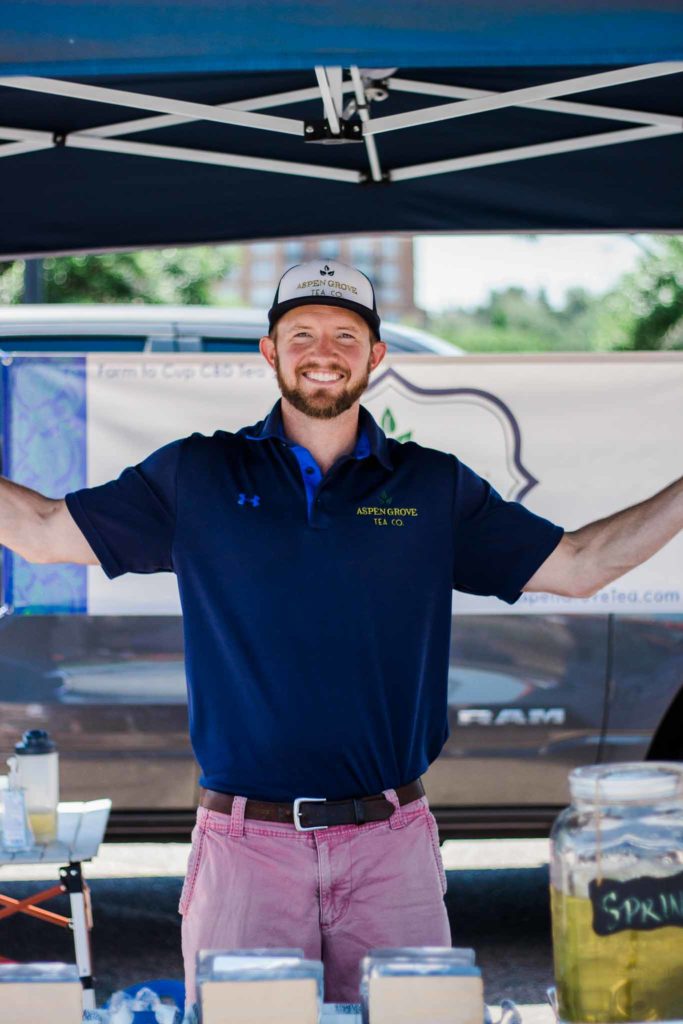Learning my CBDs
photos and editorial by Kelly Franson, Slow Food Youth Network
 Strolling down a sun-kissed street lined with a vibrant variety of vendors selling everything from fresh kale to pickled eggs to vegan cookies, I took a refreshing sip of some ice cold CBD tea from the Aspen Grove Tea booth. Here at the Cherry Creek Farmers’ Market in Denver you can find a frenzy of CBD-infused products.
Strolling down a sun-kissed street lined with a vibrant variety of vendors selling everything from fresh kale to pickled eggs to vegan cookies, I took a refreshing sip of some ice cold CBD tea from the Aspen Grove Tea booth. Here at the Cherry Creek Farmers’ Market in Denver you can find a frenzy of CBD-infused products.
As a native Coloradan, I witnessed the CBD craze take root early on but didn’t buy into it until I moved to Berkeley, the supposed birthplace of CBD boba tea – I of course had to try it then! I was intrigued by its ability to heal and soothe ailments, but wondered if it really was just a placebo effect. So I dove into learning more about its cultivation, production, and usage.
CBD, or cannabidiol, can either be derived from the hemp plant or the marijuana plant, the former being legal on the federal level and the latter being illegal on the federal level. Technically, hemp and marijuana are the same plant species Cannabis sativa, and the only difference is the THC (a cannabinoid molecule) level – hemp must have less than 0.3% THC. Hemp is typically grown for its fiber and nutritive seeds, but its flowers, leaves, and stems are used to produce CBD oil.
From an agricultural perspective, the commercialization of cannabis production has moved the industry in a direction that poses considerable dangers to the environment. Given the increasingly competitive nature of the space, producers have turned to artificial fertilizers and pesticides to improve yields. It’s also incredibly water-intensive (it takes 1,170 liters to grow one cannabis plant – that’s enough for eighteen 10 minute showers!) which has even led to water theft where supply is scarce and expensive.
 From a health perspective, the strongest scientific evidence for CBD’s healing abilities stems from a few studies showing that CBD is effective in decreasing and in some cases eliminating the number of seizures among children with serious epilepsy syndromes. While more research is still needed to understand its other health benefits, CBD is marketed for its ability to soothe anxiety, ease insomnia, and reduce chronic pain. As tempting as its health benefits may be, try to avoid hopping online to buy the first CBD oil you find. The FDA currently doesn’t regulate dietary supplements, so it’s important to do a bit of research and make sure you know what you’re really getting (pesticide contamination and unknown dosage levels are big no-nos). Thankfully, sellers like Aspen Grove Tea provide certificates confirming exactly how much pure CBD isolate is within their products.
From a health perspective, the strongest scientific evidence for CBD’s healing abilities stems from a few studies showing that CBD is effective in decreasing and in some cases eliminating the number of seizures among children with serious epilepsy syndromes. While more research is still needed to understand its other health benefits, CBD is marketed for its ability to soothe anxiety, ease insomnia, and reduce chronic pain. As tempting as its health benefits may be, try to avoid hopping online to buy the first CBD oil you find. The FDA currently doesn’t regulate dietary supplements, so it’s important to do a bit of research and make sure you know what you’re really getting (pesticide contamination and unknown dosage levels are big no-nos). Thankfully, sellers like Aspen Grove Tea provide certificates confirming exactly how much pure CBD isolate is within their products.
After reading about some of the irresponsible and wasteful production habits in the cannabis industry, I was initially hesitant to try out any CBD products, but was relieved to find Aspen Grove which prides itself on responsibly sourced, small-batch tea & organic, high-grade CBD. They’ve even come up with the perfect phrase to describe their ideals: Farm to Cup CBD Tea™. I was met at the booth by Bobby who proudly let us sample their delicious Awake infusion, a blend between Earl Grey, orange, lavender, and bergamot that tasted heavenly. Because of my special soft spot for green tea, my personal favorite was their Spring blend which had Dragonwell green tea, sunflower and cornflower petals, and strawberry rhubarb flavorings.
The next time you feel like caving into the CBD craze, remember to research where your product came from and what’s in it. Your local farmers market is a great place to start!
To learn more about Aspen Grove Tea Co. visit their website or their Instagram.
Photos by Kelly Franson

